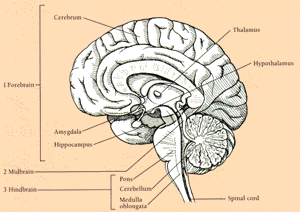
When someone compares learning a new skill to learning how to ride a bike
they imply that once mastered, the task seems imbedded in your brain forever.
Well, imbedded in the cerebellum to be exact. This brain structure is the guru
of coordinated movement and possibly even some forms of cognitive learning. Two
peach-size mounds of folded tissue at the base of the brain form the cerebellum.
Damage to this area leads to motor or movement difficulties. Some scientists
have discovered cognitive problems as well. This, along with other studies
suggest that the cerebellum is involved with these two functions.
Scientists believe the structure coordinates movement of muscles and joints by synthesizing data from the brain stem, the spinal cord, and another brain area called the cerebral cortex along with sensory input from muscles and other areas. The brain stem and spinal cord provide information on body positioning and the cerebral cortex is responsible for all conscious experience, including perception, emotion and planning.
Some scientists suspect that there are two main information pathways in the cerebellum that interact to synthesize incoming information. One carries a large amount of data from different brain and body areas and contains memory cells. The other originates in the brain stem and interacts with the first pathway to learn new patterns of movement based on incoming information. New skills are learned by trial and error and then coded into the cerebellar memory. Clinical observations suggest that mental activities also are coordinated in the cerebellum in a similar manner.